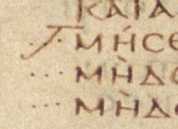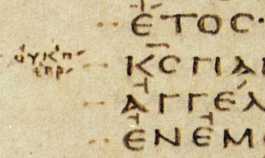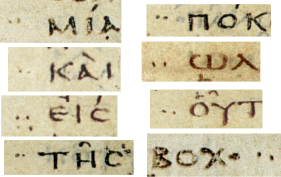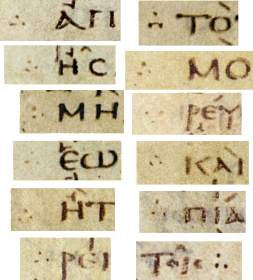Codex Vaticanus Graece 1209, B/03
Observations in the Old Testament
 715 A 24 L
715 A 24 L e.g. p. 987 C / 992 A / 996 A,C / 1000 A / 1003 B / 1005 B / 1028 B / 1029 A,C / 1032 B / 1034 B / 1035 C / 1038 A,C / 1040 B / 1041 C / 1046 C / 1050 B / 1051 A,B,C / 1053 B,C / 1054 B / 1055 A,B / 1056 B / 1058 A / 1060 B / 1061 A / 1062 B /
e.g. p. 987 C / 992 A / 996 A,C / 1000 A / 1003 B / 1005 B / 1028 B / 1029 A,C / 1032 B / 1034 B / 1035 C / 1038 A,C / 1040 B / 1041 C / 1046 C / 1050 B / 1051 A,B,C / 1053 B,C / 1054 B / 1055 A,B / 1056 B / 1058 A / 1060 B / 1061 A / 1062 B / Contra Payne there are umlauts in the OT. Albeit I counted only about 15. Are these of the same kind as those in the NT? I don't know. But I am tempted to assign them to variant signs. Even with the limited Rahlfs apparatus I found variants here. Of 14 safe umlauts I have found variants for 10 of them.
Contra Payne there are umlauts in the OT. Albeit I counted only about 15. Are these of the same kind as those in the NT? I don't know. But I am tempted to assign them to variant signs. Even with the limited Rahlfs apparatus I found variants here. Of 14 safe umlauts I have found variants for 10 of them. The interesting sign is what might be called a triplet. Three little dots arranged as a triangle. I have found about 75. Again, there are probably more. The last one I have found is on p. 875. The sign is very small and I have found about 22 (28%) which are not retraced and very faded. I am not sure what these are. Spot checks show variants here too. Nevertheless it appears that more than what one would expect from randomness appear at the beginning of a sentence, rarely paragraph though. 14 are on the first line of a column. I am not sure what to make of this.
The interesting sign is what might be called a triplet. Three little dots arranged as a triangle. I have found about 75. Again, there are probably more. The last one I have found is on p. 875. The sign is very small and I have found about 22 (28%) which are not retraced and very faded. I am not sure what these are. Spot checks show variants here too. Nevertheless it appears that more than what one would expect from randomness appear at the beginning of a sentence, rarely paragraph though. 14 are on the first line of a column. I am not sure what to make of this. Now, what is most interesting is, that on the first page of the supplement for the Psalms
(p. 695-704) there is one such symbol, too.
Now, what is most interesting is, that on the first page of the supplement for the Psalms
(p. 695-704) there is one such symbol, too.  Remember that on the first page of the NT supplement (Heb, Rev) there is an umlaut, at approximately the same position. No further umlauts/triplets can be found in these supplements.
Remember that on the first page of the NT supplement (Heb, Rev) there is an umlaut, at approximately the same position. No further umlauts/triplets can be found in these supplements.